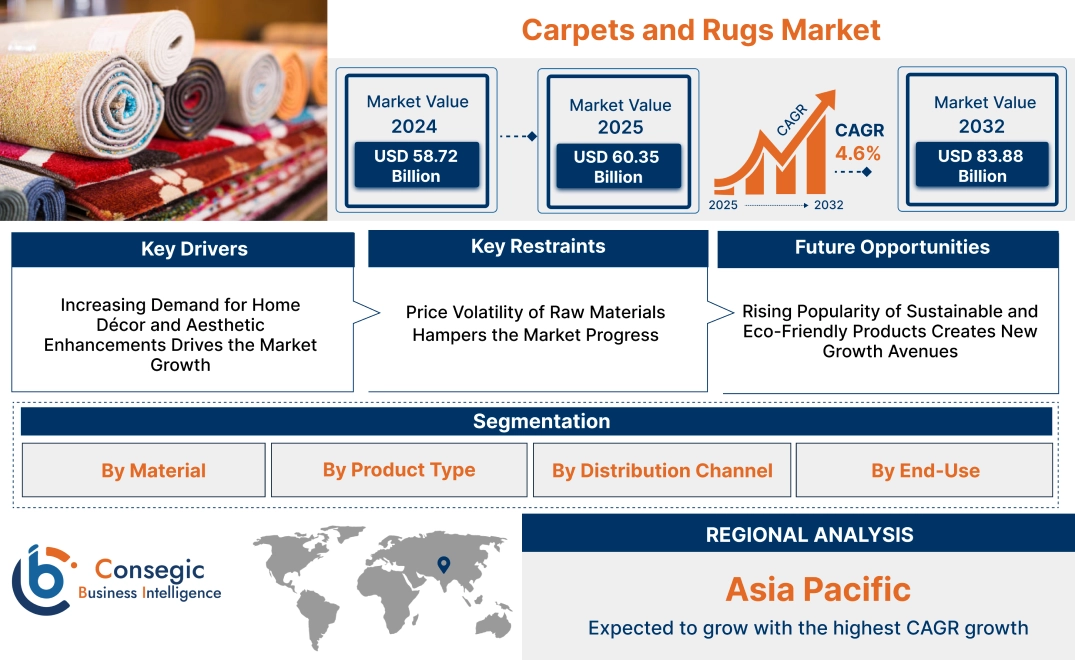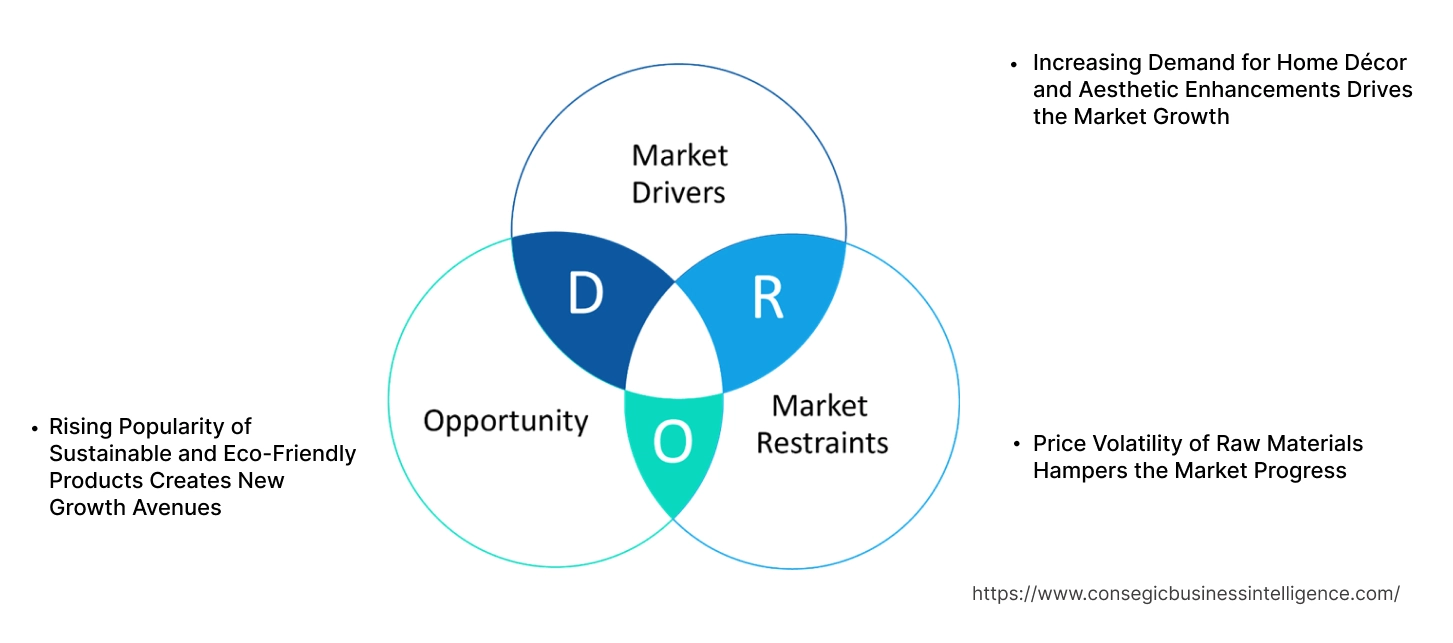- Summary
- Table Of Content
- Methodology
Carpets and Rugs Market Size:
Carpets and Rugs Market size is estimated to reach over USD 83.88 Billion by 2032 from a value of USD 58.72 Billion in 2024 and is projected to grow by USD 60.35 Billion in 2025, growing at a CAGR of 4.6% from 2025 to 2032.
Carpets and Rugs Market Scope & Overview:
Carpets and rugs are textile floor coverings used for decorative, functional, and comfort purposes in residential, commercial, and industrial spaces. These products are available in a variety of materials, designs, and sizes to suit different aesthetic and practical requirements. They enhance interior spaces by providing insulation, noise reduction, and protection for flooring surfaces.
These floor coverings are manufactured using materials such as wool, nylon, polyester, and polypropylene, each offering unique durability and texture properties. They are available in various types, including woven, tufted, and knotted styles, catering to diverse consumer preferences. Advanced manufacturing techniques also allow for customization in design, color, and texture, making them suitable for different applications.
End-users include homeowners, businesses, hospitality establishments, and institutional facilities that require flooring solutions for comfort, aesthetics, and functionality. Carpets and rugs play a significant role in interior design, contributing to both decorative and practical aspects of space management.
Key Drivers:
Increasing Demand for Home Décor and Aesthetic Enhancements Drives the Market Growth
As the consumers focus more on personalizing their living spaces, rugs and carpets are key elements in creating comfortable, aesthetically pleasing environments. These products not only enhance the look of a room but also add warmth and texture, making them an essential part of modern home décor. With increasing disposable incomes in regions such as North America, Europe, and parts of Asia-Pacific, consumers are investing more in quality home furnishings. This trend is especially strong among millennials and middle-income groups, who prioritize style, comfort, and sustainability in their purchasing decisions. The ability to transform a space with diverse designs, colors, and materials, such as eco-friendly fibers and customizable options, is fueling the carpets and rugs market growth, making it an integral part of interior design and home improvement.
Key Restraints:
Price Volatility of Raw Materials Hampers the Market Progress
Price volatility of raw materials, such as wool, synthetic fibers, and dyes, significantly impacts the market. Fluctuations in the cost of these materials, driven by factors like global supply chain disruptions, agricultural conditions, or geopolitical events, result in unpredictable pricing for manufacturers. For instance, fluctuations in wool prices due to changes in livestock production or synthetic fiber costs driven by petroleum price variations directly affect the production costs of carpets and rugs. These increases in raw material prices often lead to higher retail prices for consumers, potentially reducing demand, especially in price-sensitive markets. Additionally, manufacturers face difficulties in forecasting costs and managing inventory, making it difficult to maintain stable pricing. As a result, consumers opt for alternative flooring solutions or delay purchasing, which hinders carpets and rugs market demand. This price volatility makes it challenging for both producers and consumers to anticipate and manage costs effectively.
Future Opportunities :
Rising Popularity of Sustainable and Eco-Friendly Products Creates New Growth Avenues
Consumers are becoming more environmentally conscious, seeking products that align with their values of sustainability and reduced environmental impact. In response, manufacturers are increasingly offering carpets made from recycled materials, organic fibers, and biodegradable components. These products not only reduce waste but also minimize the carbon footprint associated with production. Materials like natural wool, bamboo, and jute are gaining popularity, offering eco-friendly alternatives to traditional synthetic fibers. Additionally, advances in eco-friendly dyes and non-toxic adhesives are contributing to the development of greener options. As consumers prioritize sustainability in their purchasing decisions, demand for environmentally friendly flooring solutions is expected to continue growing, creating significant opportunities for manufacturers to expand their product offerings and cater to this conscious consumer base. Thus, the above factors are boosting the carpets and rugs market opportunities.
Carpets and Rugs Market Segmental Analysis :
By Material:
Based on material, the market is segmented into nylon, polyester, polypropylene, wool, and others.
The nylon segment accounted for the largest revenue of 35.6% of the total carpets and rugs market share in 2024.
- Nylon carpets and rugs are widely used due to their durability, stain resistance, and resilience, making them ideal for high-traffic areas in both residential and commercial settings.
- These carpets offer excellent elasticity and abrasion resistance, ensuring longevity and ease of maintenance, which enhances their preference among consumers.
- Nylon fibers are often treated with stain-resistant coatings, increasing their suitability for homes, hospitality, and office environments where cleanliness is a priority.
- As per carpets and rugs market analysis, the segment benefits from trends toward eco-friendly and recycled nylon materials, addressing sustainability concerns in the carpet and rug industry.
The polyester segment is anticipated to grow at the fastest CAGR during the forecast period.
- Polyester carpets are known for their softness, vibrant color retention, and affordability, making them popular in residential applications.
- The segment benefits from advancements in fiber technology that enhance the moisture resistance and durability of polyester carpets, improving their suitability for various indoor environments.
- Increasing demand for cost-effective and aesthetically appealing carpets supports the expansion of this segment, particularly in budget-conscious markets.
- Thus, the availability of recycled polyester fibers aligns with industry trends focused on sustainable flooring solutions, driving the carpets and rugs market expansion.
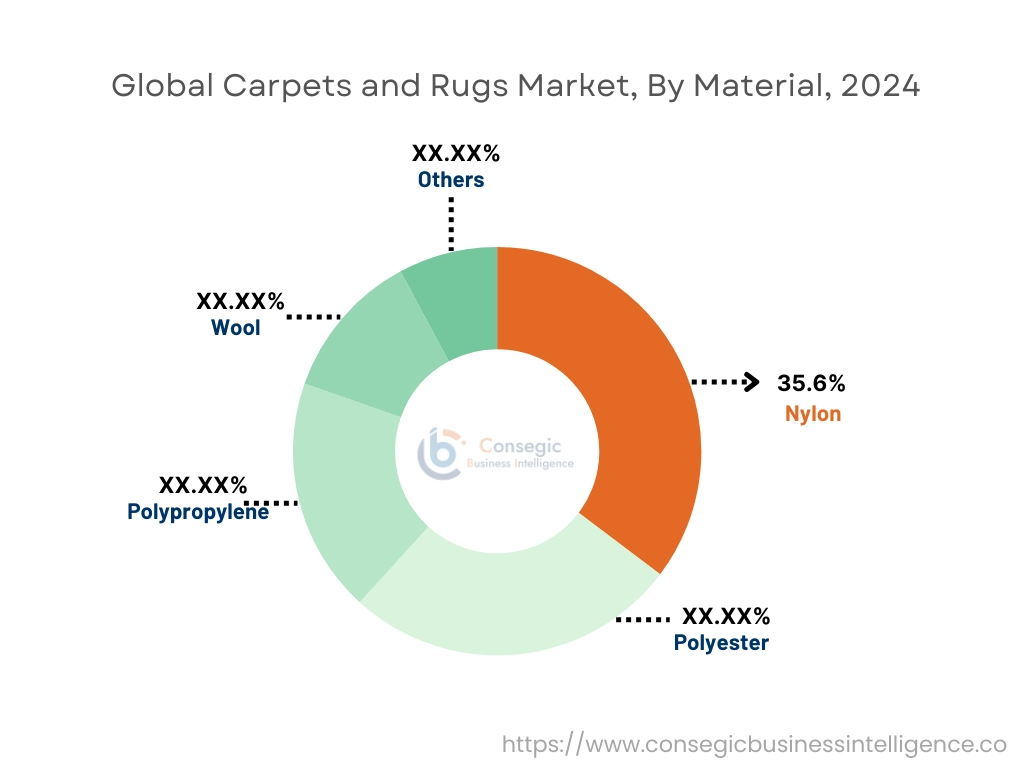
By Product Type:
Based on product type, the market is segmented into woven, tufted, knotted, needle-punched, and others.
The tufted segment accounted for the largest revenue of the total carpets and rugs market share in 2024.
- Tufted carpets dominate the market due to their cost-effectiveness, rapid production, and availability in various designs and textures.
- These carpets are extensively used in residential and commercial applications, offering a balance between affordability and durability.
- Tufted carpets are available in multiple pile heights and densities, allowing customization for different usage scenarios, such as offices, hotels, and homes.
- As per carpets and rugs market trends, innovations in tufting technology have led to the development of more durable and stain-resistant carpets, increasing their popularity across various end-user industries.
The woven segment is anticipated to grow at the fastest CAGR during the forecast period.
- Woven carpets, typically made using traditional loom techniques, offer superior durability and intricate design patterns, making them a preferred choice for luxury spaces.
- These carpets are commonly found in high-end hotels, luxury residences, and commercial spaces where aesthetics and durability are equally important.
- The segment benefits from the growth in appreciation for handcrafted and premium-quality carpets, particularly in international markets with a preference for traditional designs.
- As per carpets and rugs market analysis, the demand for woven carpets in heritage and culturally significant spaces continues to expand their presence in the industry.
By Distribution Channel:
Based on distribution channel, the market is segmented into online retail and offline retail.
The offline retail segment accounted for the largest revenue share in 2024.
- Consumers prefer offline retail channels, such as specialty carpet stores and home furnishing outlets, to experience the texture, quality, and appearance of carpets before purchase.
- Showrooms and retail stores provide expert assistance, helping customers select the right material and design based on their needs and budgets.
- The segment benefits from established distribution networks and partnerships between manufacturers and retailers, ensuring product availability across various regions.
- As per carpets and rugs market trends, the presence of exclusive brand outlets and large home décor stores continues to reinforce the dominance of offline retail.
The online retail segment is anticipated to grow at the fastest CAGR during the forecast period.
- The convenience of online shopping, combined with the availability of a wide range of carpet designs, colors, and materials, has fueled the adoption of digital sales channels.
- E-commerce platforms provide competitive pricing, discounts, and doorstep delivery, making them an attractive option for tech-savvy and budget-conscious consumers.
- Virtual visualization tools and augmented reality (AR) applications enable customers to preview carpets in their home spaces, enhancing the online shopping experience.
- Thus, the increasing reliance on digital platforms for home improvement products supports the rapid extension of online retail in the carpet industry, fueling the carpets and rugs market growth.
By End User:
Based on end-use, the market is segmented into residential and commercial.
The residential segment accounted for the largest revenue share in 2024.
- Carpets and rugs are widely used in households for aesthetic enhancement, insulation, and comfort, making residential spaces the largest end-user segment.
- The segment benefits from the increasing adoption of area rugs and wall-to-wall carpeting as part of modern home décor trends.
- Consumers prefer carpets for their ability to reduce noise, enhance indoor air quality, and provide a cozy environment in living spaces and bedrooms.
- Therefore, the rising interest in personalized home interiors drives the carpets and rugs market demand.
The commercial segment is anticipated to grow at the fastest CAGR during the forecast period.
- Commercial spaces, including hotels, offices, retail stores, and event venues, rely on carpets for durability, noise reduction, and aesthetic appeal.
- High-traffic areas in commercial settings require carpets with enhanced stain resistance and durability, leading to the adoption of high-performance carpet solutions.
- The segment benefits from innovations in modular carpet tiles, which allow for easy replacement and customization in office and hospitality environments.
- Therefore, the emphasis on sustainability in commercial flooring solutions has led to the development of eco-friendly carpets with recyclable materials, creating substantial carpets and rugs market opportunities.
Regional Analysis:
The regions covered are North America, Europe, Asia Pacific, the Middle East and Africa, and Latin America.
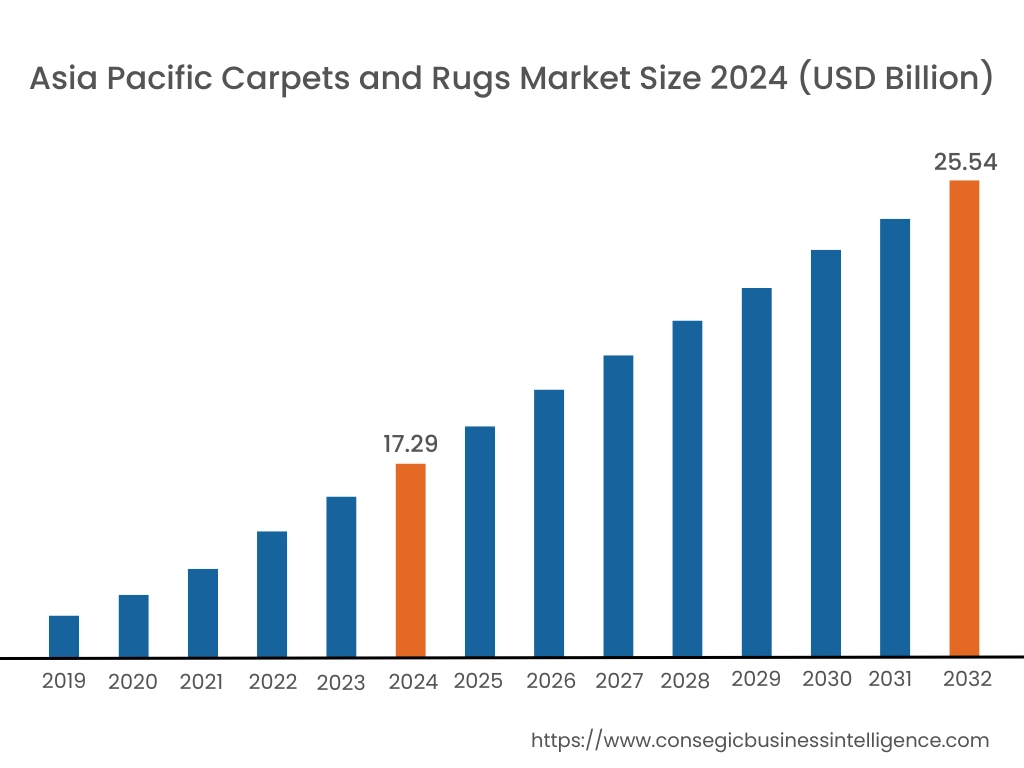
Asia Pacific region was valued at USD 17.29 Billion in 2024. Moreover, it is projected to grow by USD 17.82 Billion in 2025 and reach over USD 25.54 Billion by 2032. Out of this, China accounted for the maximum revenue share of 31.5%. The Asia-Pacific region is witnessing rapid advancements in the carpets and rugs market, attributed to increasing urbanization and disposable incomes. A prominent trend is the rising need for affordable yet stylish floor coverings, with consumers favoring synthetic materials that offer durability and design versatility. Analysis indicates that the growth in middle-class population and housing developments are contributing to carpets and rugs market expansion in this region.
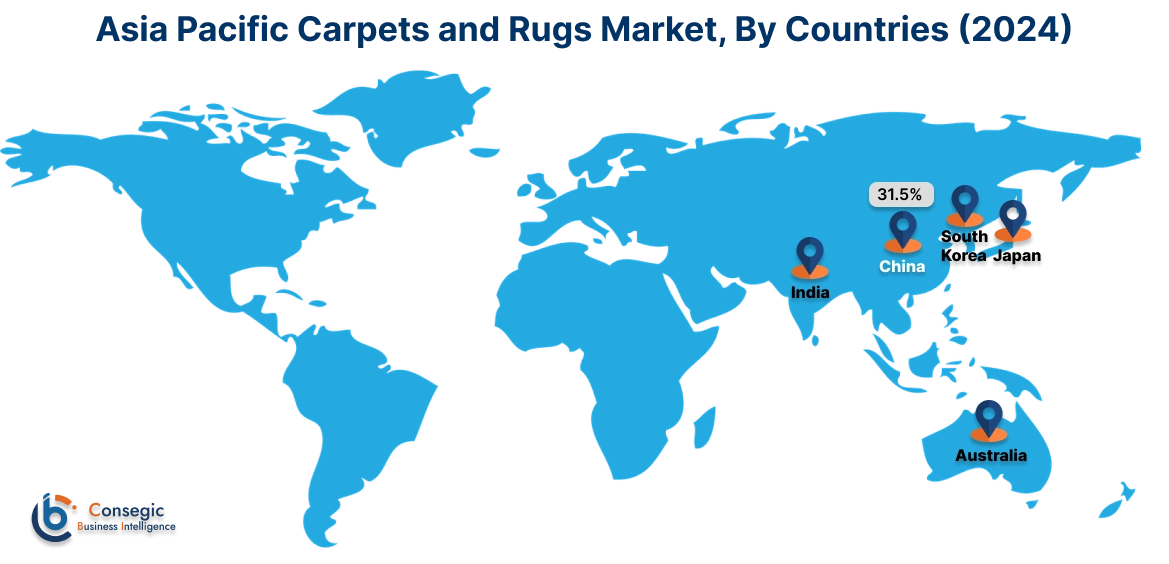
North America is estimated to reach over USD 27.19 Billion by 2032 from a value of USD 19.48 Billion in 2024 and is projected to grow by USD 19.98 Billion in 2025. This region maintains a significant position in the carpets and rugs sector, driven by a resurgence in the popularity of carpeted interiors. A notable trend is the increasing preference for wall-to-wall carpeting, as consumers seek comfort and warmth in their living spaces. Analysis indicates that the focus on energy efficiency and noise reduction contributes to the market dynamics in North America.
European countries are pivotal in the carpets and rugs market, emphasizing sustainable materials and artisanal craftsmanship. A significant trend is the integration of eco-friendly fibers and traditional weaving techniques, catering to environmentally conscious consumers. Analysis suggests that the commitment to sustainability and aesthetic appeal drives the adoption of these products in this region.
In the Middle East and Africa, the carpets and rugs market is influenced by a rich tradition of textile craftsmanship and a preference for luxurious interiors. The focus is on high-quality, handcrafted rugs that reflect cultural heritage and artistry. Analysis suggests that the tourism and hospitality sectors' enlargement, along with a penchant for opulent home decor, are shaping the market landscape in these regions.
Latin American countries are increasingly recognizing the benefits of incorporating vibrant and culturally inspired carpets and rugs into interior design. A notable trend is the use of bold patterns and colors that reflect local traditions, appealing to both domestic and international markets. Analysis indicates that economic development and a growing appreciation for cultural aesthetics are key factors influencing the market in this region.
Top Key Players and Market Share Insights:
The Carpets and Rugs market is highly competitive with major players providing products and services to the national and international markets. Key players are adopting several strategies in research and development (R&D), product innovation, and end-user launches to hold a strong position in the global Carpets and Rugs market. Key players in the Carpets and Rugs industry include -
- Mohawk Industries, Inc. (USA)
- Shaw Industries Group, Inc. (USA)
- Jaipur Rugs Company Pvt. Ltd. (India)
- Dixie Group, Inc. (USA)
- Victoria PLC (UK)
- Tarkett Group (France)
- Beaulieu International Group (Belgium)
- Balta Group (Belgium)
- Associated Weavers International Group (Belgium)
- Tai Ping Carpets International Ltd. (Hong Kong)
Carpets and Rugs Market Report Insights :
| Report Attributes | Report Details |
| Study Timeline | 2019-2032 |
| Market Size in 2032 | USD 83.88 Billion |
| CAGR (2025-2032) | 4.6% |
| By Material |
|
| By Product Type |
|
| By Distribution Channel |
|
| By End-Use |
|
| By Region |
|
| Key Players |
|
| North America | U.S. Canada Mexico |
| Europe | U.K. Germany France Spain Italy Russia Benelux Rest of Europe |
| APAC | China South Korea Japan India Australia ASEAN Rest of Asia-Pacific |
| Middle East and Africa | GCC Turkey South Africa Rest of MEA |
| LATAM | Brazil Argentina Chile Rest of LATAM |
| Report Coverage |
|
Key Questions Answered in the Report
What is the size of the Carpets and Rugs Market? +
The Carpets and Rugs Market size is estimated to reach over USD 83.88 Billion by 2032 from a value of USD 58.72 Billion in 2024 and is projected to grow by USD 60.35 Billion in 2025, growing at a CAGR of 4.6% from 2025 to 2032.
What are the key segments in the Carpets and Rugs Market? +
The market is segmented by material (nylon, polyester, polypropylene, wool, others), product type (woven, tufted, knotted, needle-punched, others), distribution channel (online retail, offline retail), and end-use (residential, commercial).
Which segment is expected to grow the fastest in the Carpets and Rugs Market? +
The polyester segment is projected to see increasing adoption during the forecast period, driven by advancements in fiber technology that enhance its durability and moisture resistance.
Who are the major players in the Carpets and Rugs Market? +
Key players in the Carpets and Rugs Market include Mohawk Industries, Inc. (USA), Shaw Industries Group, Inc. (USA), Tarkett Group (France), Beaulieu International Group (Belgium), Balta Group (Belgium), Associated Weavers International Group (Belgium), Tai Ping Carpets International Ltd. (Hong Kong), Jaipur Rugs Company Pvt. Ltd. (India), Dixie Group, Inc. (USA), Victoria PLC (UK).
